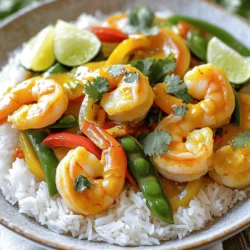
- Coconut Curry Shrimp
Indulge in the tropical flavors of Coconut Curry Shrimp with this easy recipe that will transport your taste buds to paradise! Featuring succulent shrimp bathed in a creamy coconut sauce, vibrant veggies, and aromatic spices, this dish is perfect for a quick weeknight dinner. Ready in just 20 minutes, it pairs beautifully with jasmine rice. Click through to discover this delightful recipe and bring a touch of the tropics to your kitchen!